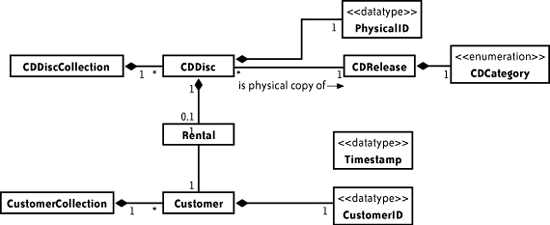7.1. Where We Are
Let us look at the classes we have developed so far. Figure 7-1 gives the overall picture, and the listing in Example 7-1 gives the details.
Example 7-1. Class details for the system so far
class CDRelease
CommonString title
UPCCode upc_code
CDCategory category
Days base_rental_period( )
Dollars get_rental_fee( )
class CDDisc
CDRelease cd_release
PhysicalID physical_id
Rental current_rental
start_rental(Customer the_renter)
end_rental( ) //
class PhysicalID
class CDCategory
class Rental
Customer renter
Timestamp start_time
Timestamp end_time
Days base_rental_period
Boolean is_overdue( )
class CDDiscCollection
CDDisc find_by_physical_id(PhysicalID a_physical_id)
CDDisc [] find_by_cd_release(CDRelease a_cd_release)
// Standard collection operations:
add(CDDisc a_cd_disc)
remove (CDDisc a_cd_disc)
class CustomerID
class Customer
CustomerID customer_id
CommonString name
class CustomerCollection
Customer find_by_customer_id(CustomerID a_customer_id)
// Standard collection operations
add(Customer customer_to_add)
remove(Customer a_customer_id) // Check to see no current rentals
|
We have two use cases that we are developing: Checkout_a_CDDisc and Checkin_a_CDDisc. Figure 7-2 gives an overall sequence diagram for the Checkout_a_CDDisc case.
Figure 7-1. Class diagram for the system so far

Figure 7-2. Checkout_a_CDDisc
Likewise, Figure 7-3 gives a sequence diagram ...
Get Prefactoring now with the O’Reilly learning platform.
O’Reilly members experience books, live events, courses curated by job role, and more from O’Reilly and nearly 200 top publishers.

